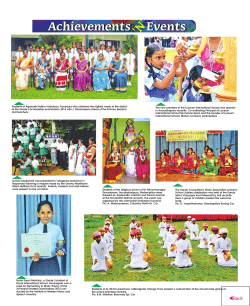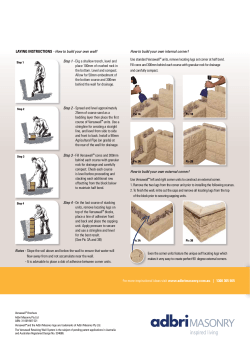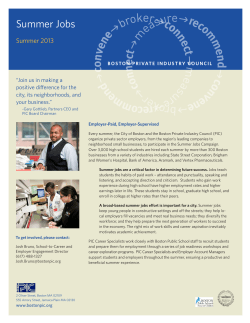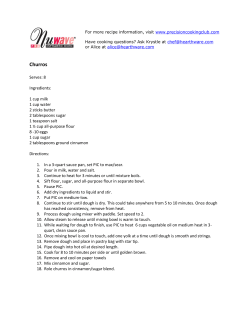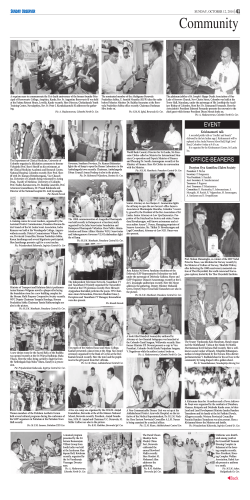
What you need
How to make a handmade book What you need This week, we show you how to make a simple book. We’ll also show you how to put a decorative hard cover on your book and mount your story so it looks really good! l Method 1. To work out how many sheets of paper you need, decide how many pages your book should have. Each sheet will make 4 pages in the finished book. Divide the number of pages you want your book to be, by 4. Round up the answer to the next whole number, then add 1. So, if your book is 17 pages, you will need to have 6 sheets of paper. l l 2. Fold each sheet of paper (including the cover) carefully in half, pressing down the fold using the handle of the blunt knife. Place each sheet inside each other to make a ‘section’ and slot it into the cover. 3. Clip the pages of the section together, with the paperclips at the top and bottom (or ‘head’ and ‘tail’) of the book, on either side of the fold. 1 3 l l l l l l l l Paper for book pages* 1 sheet of coloured paper for the cover** Binding material – use thin ribbon or thin leather strap or elastic cord etc for holding the pages together Blunt table knife – to flatten your folds An ‘awl’ – a sharp tool for making a hole through your paper – you can use a thick embroidery needle (push the blunt end into a cork, so you have a ‘handle’), or a very small flat headed screwdriver Masking tape Scissors Paperclips Pencil Ruler An adult to help * you can use plain A4 paper, but if possible use slightly larger, slightly heavier, coloured paper for the pages (see Extra Info section below). ** this should be thicker than the paper used for the pages, but the same size 4. Measure and mark on the inside of the fold, where you will make the 2 holes for the ribbon to pass through. We placed the holes about 3cm from the top and bottom. Using the ‘awl’, make 2 holes through the ‘spine’ of the book. Ask an adult to help you. (see pic 1) 5. Measure out the binding material – it should be 3 or 4 times as long as the distance between the 2 holes. Wrap a tiny piece of masking tape around the very tip of the ribbon and, using the awl, push it through the hole from the inside to the outside of the book. Do the same with the other end. (see pic 2) 2 6. Tie a bow in the ribbon, and cut the ends at an angle to stop it from fraying. You can tie beads or charms to the ribbon as decoration. (see pic 3) EXTRA INFO If you need to cut out a cover from a large sheet of paper, test the paper first to see which way it folds more easily (ie along the width or the length) – and make sure you fold your cover in that direction. This is called cutting ‘along the grain’ – it will fold more easily and lie flatter. Ask an adult to help you cut the cover out with a craft knife – use a setsquare to make sure your corners are perfect right angles. (see pic) Thanks to Louise Garnaut at ‘Bookworks’ – a company that specializes in handmade books and book binding – for her help with this project. For more information about Bookworks, please email info@bookworks.com.hk Make a hard cover This week we show you how to put a hard cover on the book you made last week! 1 What you need l l l l l l l paper with nice design – used wrapping paper is fine OR felt/material in a design you like. Double sided tape * Cereal box – must be larger than the size of the book! Craft knife Ruler Adult to help Handmade book prepared last week Method 1. Cut the cereal box so you have the 2 large side panels. (pic 1) 2 2. Using your book as a guide, ask an adult to help you to cut 2 rectangles (the cover) from the cereal boxes, using a craft knife and a ruler or set square. (pic 2) The rectangles should be very slightly larger than the handmade book. 3 5 3. Again, using a ruler and craft knife, ask an adult to cut out 2 rectangles from your covering material – ie patterned paper/felt/material – we 4 used wrapping paper**. The rectangles should be about 2cm larger all around, than each of your covers. Put double sided tape on the edges of the cardboard ‘cover’ – being careful to put it onto the least colourful side, so the design on the box cannot be seen through the paper covering it. (pic 3) 4. Starting at the bottom, carefully smooth the paper onto the cardboard, so that you don’t get any wrinkles or bubbles. (pic 4) 6 5. Turn all 4 corners of the wrapping paper in, then put double sided tape on the edges of the wrapping paper. Fold the edges onto the cardboard, so you get nice square corners. (pic 5) 7 6. Now place double sided tape on the INSIDE of the hard cover. Don’t put the tape right at the edge of the hard cover, except for the one which will be stuck along the spine of your book. (pic 6) 7. Stick it carefully onto the cover of your handmade book – lining it up so that the edge is about ½cm away from the spine. (pic 7). Press firmly all over the cover. 8. You can have one plain cover and one with a pattern, both the same, or two of different designs! (pic 8) Next week, we will show you how to mount your story, finish off your book, and also make a matching covered pencil! *If you are going to use felt, or material to cover your book with, use a thick spongy double sided tape. ** If you are covering your book with used wrapping paper, be aware of the design on the paper – to make sure it is centred properly. Smooth out the wrinkles by running a slightly damp cloth over the paper. Thanks to Louise Garnaut at ‘Bookworks’ – a company that specializes in handmade books and book binding – for her help with this project. For more information about Bookworks, please email info@bookworks.com.hk 8 Mount your book – part 3 What you need l l l l l l l This week we show you how to mount the story you have written, in the book you have made – and also how to make a matching covered pencil! Method 1. First, write or print out your story, and draw any illustrations on sheets of paper (ie not straight into your handmade book). Be careful to trim each sheet of paper to the same size – to fit easily on the pages of your 1 book. Ask an adult to help you with this. We recommend that you use a font size 16 or 18 to print out your story, and that you spread the text out over several pages. 2. Take the sheet of patterned paper and cut a rectangle, which is about 2cm smaller than your book, both in length and width. This will be a ‘decorative plate’ for your title page. 3. Use double sided tape or glue to carefully stick the decorative plate in the centre of the 1st page. (Pic 1) 4. Cut out another rectangle – about 1cm smaller than the Handmade book – hard cover optional One sheet patterned paper – used wrapping paper is fine. Double sided tape, or glue stick Scissors or craft knife Your story – printed out/handwritten Story illustrations An adult to help decorative plate – out of plain paper. Write the title of the story and the author’s name, in large letters on it. Then stick this down in the centre of the decorative plate. (pic 2) 2 5. Plan where the pages go, making sure to place the illustrations where they best fit the text. When you have decided, carefully stick each page into your book. (pic 3) 6. Congratulations – you’ve finished! If you have lots of pages left in 3 your handmade book, consider writing another story to fill it up, or write a profile of the author (yourself!) with a photo, so that the reader can learn a little about you. Covering a pencil 1. Measure the pencil and cut a rectangle out of patterned paper. Make it a little shorter than the pencil, and wide enough to wrap once around it with a 5mm overlap. (pic 1) 1 2. Rub the pencil with sandpaper until it feels slightly rough. (pic 2) 2 3. Mix some PVA glue with a little water. Using a brush, cover the non patterned side of the paper completely with the glue mixture. (pic 3) 3 4. Place the paper onto the pencil so that it is lined up straight along its length. 5. Making sure that your hands are clean and dry, hold the pencil by its tip. Then smooth the paper down onto the pencil using your thumb and 4 forefinger, until the paper is wrapped completely around it. (pic 4) 6. Wait until the glue is totally dry before sharpening the pencil. Thanks to Louise Garnaut at ‘Bookworks’ – a company that specialises in handmade books and book binding – for her help with this project. For more information about Bookworks, please email info@bookworks.com.hk What you need l l l l l l Pencil PVA glue Sandpaper Patterned paper Craft knife/scissors brush
© Copyright 2025
